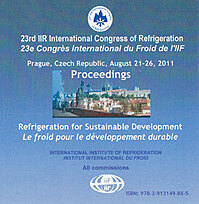
Summary
A transcritical carbon dioxide (CO2) Rankine power cycle has been analyzed based on first and second law of thermodynamics. Detailed simulations using distributed models for the heat exchangers have been performed in order to develop the performance characteristics in terms of e.g., thermal efficiency, exergetic efficiency and specific net power output. A generic cycle configuration has been used for analysis of a geothermal energy heat source. This model has been validated against similar calculations using industrial waste heat as the energy source. Calculations are done with fixed temperature and mass flow of the heat source. The results show the existence of an optimum high pressure for maximizing performance and for minimizing the heat transfer area. The exergy analysis specifies points of potential improvement in the heat exchanger temperature match and points to optimal operating conditions for the high side pressure. In addition the results underline that the investment cost for additional heat exchange components such as an internal heat exchanger may be unprofitable in the case where the heat source is free.
Available documents
Format PDF
Pages: 8 p.
Available
Public price
20 €
Member price*
Free
* Best rate depending on membership category (see the detailed benefits of individual and corporate memberships).
Details
- Original title: Modeling and analysis of a transcritical Rankine power cycle with a low grade heat source.
- Record ID : 30001584
- Languages: English
- Source: Proceedings of the 23rd IIR International Congress of Refrigeration: Prague, Czech Republic, August 21-26, 2011. Overarching theme: Refrigeration for Sustainable Development.
- Publication date: 2011/08/21
Links
See other articles from the proceedings (569)
See the conference proceedings
-
Sensibilidad y diseño de un sistema de refriger...
- Author(s) : NGUYEN C., VEJE C., WILLATZEN M., et al.
- Date : 2013/06
- Languages : Spanish
- Source: Frío Calor Aire acondicionado - vol. 41 - n. 459
- Formats : PDF
View record
-
Sensitivity and design of a transcritical CO2 c...
- Author(s) : NGUYEN C., VEJE C., WILLATZEN M., et al.
- Date : 2012/06/25
- Languages : English
- Source: 10th IIR-Gustav Lorentzen Conference on Natural Working Fluids (GL2012). Proceedings. Delft, The Netherlands, June 25-27, 2012.
- Formats : PDF
View record
-
Characteristic study of supercritical fluids an...
- Author(s) : MA Y., WANG K., WANG J., et al.
- Date : 2002/01
- Languages : Chinese
- Source: HV & AC - vol. 32 - n. 144
View record
-
Design of heat exchangers for heat recovery in ...
- Author(s) : CHRISTENSEN R.
- Date : 2011/08/21
- Languages : English
- Source: Proceedings of the 23rd IIR International Congress of Refrigeration: Prague, Czech Republic, August 21-26, 2011. Overarching theme: Refrigeration for Sustainable Development.
- Formats : PDF
View record
-
A comparative study of the carbon dioxide trans...
- Author(s) : CHEN Y., LUNDQVIST P., JOHANSSON A., et al.
- Date : 2006/12
- Languages : English
- Source: Applied Thermal Engineering - vol. 26 - n. 17-18
View record
